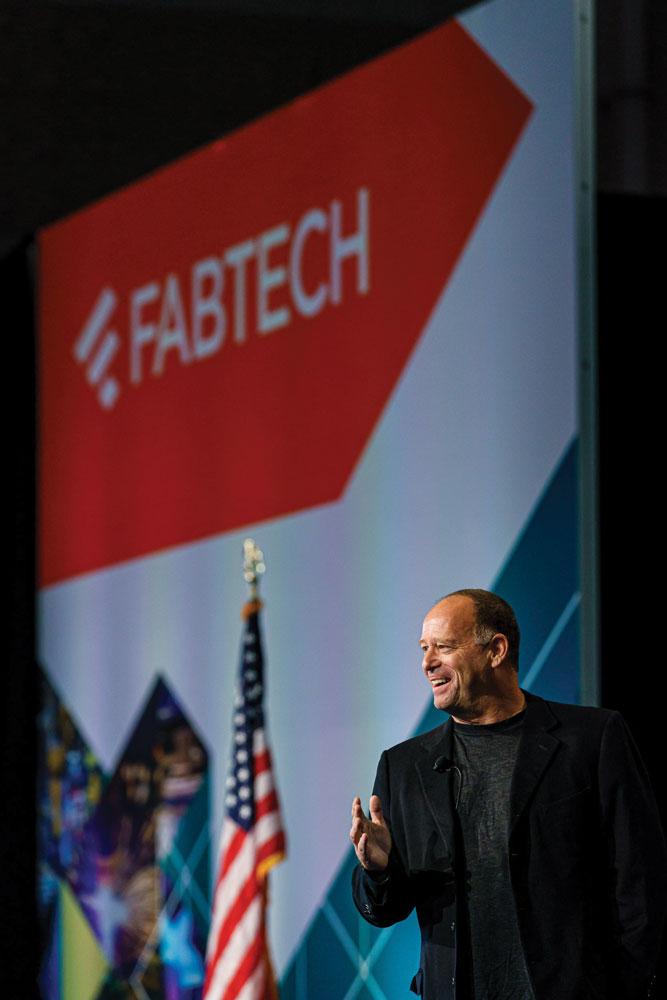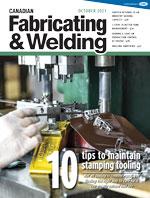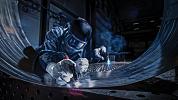- FMA
- The Fabricator
- FABTECH
- Canadian Metalworking
FABTECH returns to an industry seeking capacity
Data will help fabricators get the most out of technology
- By Tim Heston
- October 21, 2021
- Article
- Fabricating
Between Sept. 13 and 16, McCormick Place in Chicago had an energy not seen in many, many months. As one of the first major shows to grace the halls of the convention center since the pandemic, FABTECH brought together more than 24,000 people looking for new and better ways to produce.
Turnout was stronger than expected. Most important, those who attended tread the halls with purpose. They weren’t just kicking tires. They had left operations in need of more capacity, and they came to buy. “Sold” signs hung from many machines on display, and a few exhibitors reported selling nearly every piece of equipment they brought to the show.
During one conference presentation, Nathan McMurtrey, a principal at Fargo, N.D.-based Eide Bailly (www.eidebailly.com), a CPA and consulting firm, spelled out the industry’s four major challenges: finding and keeping labor; increasing raw material and transportation costs; supply chain problems; and, as McMurtrey put it, “a technology explosion as the industry tries to maximize automation.”
This year’s FABTECH exhibitors and conference presenters addressed all four, with diverse solutions spanning the entire metal supply chain. Despite the diversity, a common thread ran through the floor’s disparate collection of technology: data. Walking the show floor, you could easily see a day when this business will be as much about data as about fabricating metal parts. Even now, a fabricator’s use of data can be its key differentiator, and such differentiation will become only more important in the years to come.
About Getting on Base
During his FABx Tech Talk (modeled on the popular TED Talks) that kicked off FABTECH on Sept. 13, Jon Sobel, CEO/founder of San Francisco-based Sight Machine (www.sightmachine.com), a plant data and analytics firm, gave an insightful description of what remains mysterious for many: Marketing hype aside, what exactly is Industry 4.0?
To answer that question, Sobel talked about Moneyball, the Michael Lewis bestseller and movie that told the story of how statisticians turned a struggling baseball team into champions.
“After about 100 years of playing the game the same way,” Sobel said, “some creative folks turned to statistical thinking that had been around for years, and completely reconceived how to think about baseball.”
Until the 1990s, baseball’s powers that be focused on the quality of individual players, including their RBIs and batting averages. Instead of focusing on batting averages, the statistical minds in Moneyball focused on how often a batter got on base. The more batters got on base, the greater chance that team had of winning a game. The act of getting on base, Sobel said, is analogous to a unit of production, and the statisticians focused on assembling a team that could produce these units as efficiently as possible.
In the metal fabrication world, an incredibly productive machine or system—a ultrahigh-powered fiber laser, a comprehensive flexible manufacturing system, a new robotic welding line, or whatever else—is like a batter with an incredible batting average. Each is amazing individually, but how do they work together with every other node of production on the shop floor?
“It’s not about how much stuff we make anymore,” Sobel said. “It’s about how well we make it. Do you use the least amount of energy, and are we driving down costs?

Path Robotics uses vision to circumvent robot programming. The company’s goal is to make robotic welding autonomous.
”Knowing all this doesn’t come easy,” Sobel continued, adding that it usually involves tying together different systems and machines, some old and some new, as well as umpteen different software systems implemented over decades.
But when everything ties together, great things can happen. Back to the Moneyball metaphor, a team with batters who get on base most frequently can equate to nodes of production—be it in cutting, bending, or welding—that together get more products “on base” (that is, the product ships out the door) in less time.
Sobel described this as differentiating between “productivity” and “production.” Production simply measures volume—the tons of metal being processed in the shop, regardless of customer needs or demands. Productivity, on the other hand, is a company becoming more efficient in satisfying customer demand. From raw stock to the shipping dock, every piece of metal is exactly where it needs to be to satisfy or surpass customer expectations.
“Always bring it back to productivity,” Sobel said. “Not production. Productivity.”
Supply Chain Challenges
During the show’s State of the Industry panel, Bryan Tice, senior partner, Metal Edge Partners (www.metaledgepartners.com), a Plymouth, Minn.-based risk management firm for the metals industry, had some good news to share. Steel might become just a tad more available.
“We certainly see some positive developments,” Tice said. “We track things like steel capacity utilization, and those rates continue to hold in the 85% range. And we’ve seen service center inventories rise from their low levels. Most inventories stand at around 39 to 40 days, so we’re starting to see some cushion.”
That’s something metal fabricators across North America can appreciate as the supply chain challenges continue unabated. Fabricators are buying more raw stock than ever, at least when they can find it.
Fellow panelist Todd Ludlow, president of Ludlow Manufacturing (www.ludlowmfg.com), a Waukegan, Ill.-based custom sheet metal fabricator, shook his head and chuckled. “As I told someone here at the show, it’s gambling.”
Yes, fabricators might be caught with expensive raw stock when the pricing bubble pops, but few see that bubble popping anytime soon. Regardless, holding a lot of raw stock is less risky than running out and not being able to deliver. The cost of lost opportunity can be tremendous.
Still, holding all that raw stock has made manufacturing velocity more important than ever. “The goal has always been to automate as much as we can,” Ludlow said, who explained that his shop has added several laser cutting systems with material handling towers, automated part sorting, and upgraded software, all within the past six months. “I’m doing anything I can to not eliminate employees, but to not have to hire more, simply because I can’t find them.”

Jon Sobel, CEO/founder of Sight Machine, a plant data and analytics firm, speaks during a FABx Tech Talk (modeled on the popular TED Talks), which opened the show.
Say Goodbye to Robot Programming
Whether through offline simulation or through the teach pendant, for years programming has been a robot’s primary weakness in the high-mix/low-volume world of metal fabrication. Teach pendant programming takes time, as does offline simulation. Some systems have used parametric programming, which scales a program to work with infinitely variable part sizes, but only around certain part dimensions.
But what if a robot could behave like a human welder, who can look at a part—any part—compare it with the drawing, make the appropriate adjustments, and commence welding? At FABTECH, Columbus, Ohio-based Path Robotics (www.path-robotics.com) showed just how such a technology can work.
“Our goal is to break down the traditional barriers that a lot of manufacturers face when getting into robotics,” said Paul Boulware, director of applications engineering at Path.
The company’s technology allows fabricators to send a CAD file with weld annotations (showing the location and size of welds) to the robot. Using 3D vision, the robot “looks” at a tacked and fixtured part, compares it with the digital file, notes the differences (and there are always differences), adjusts, and commences welding.
“We’re effectively snapping those weld seams onto the actual weld topography of the part,” Boulware said.
What makes this possible goes back to the show’s common thread: innovative use of data, in this case CAD data married with 3D vision. And Path wasn’t the only company to showcase such technology—not by a long shot.
For instance, Omnirobotic (www.omnirobotic.com ), Laval, Que., exhibited its self-learning robot that, for powder coating applications, does not make use of any CAD model. Instead, the system’s vision “sees” the part in front of it and, based on a set of parameters, uses an artificial intelligence (AI) engine to determine the best way to paint it. At the show, the company showcased a new, simplified way to establish a set of behaviors that the AI engine works off of to establish the best program for every part the robot encounters.
“It’s not offline programming,” said Omnirobotic founder/CEO Francois Simard. “We’re describing how [the system] should make the toolpath, without you having to do it every time.”
Simard added that the company has other applications in shot peening and sandblasting and is now conducting R&D for AI-based weld programming. For welding, the system would need part parameters, just as a welder needs a drawing to determine the weld size, location, and technique to use. Regardless, the approach would aim for the same goal as the company’s current powder coating applications: to eliminate the need for manual programming and tear down the barriers to automation even for the most high-mix operations.
“Don’t Get Stale"
Keith Otterstatter, director of operations at Medina, Minn.-based Polaris (www.polaris.com), started his talk at FABTECH by focusing on seven key takeaways that, taken in sum, help describe the current state of the progressive shop floor.
- Flexible layout. Don’t create monuments that can’t be moved or reconfigured. As the pandemic recession proved all too clearly, anything can happen, and the progressive shop floor must be ready. That’s difficult to do in a shop floor constrained by monuments.
- Use your in-house experts. “The great folks who do that operation eight-hours-plus a day have great improvement ideas,” Otterstatter said. “Develop a continuous improvement environment that enables them to work on their ideas.”
- Use a visual, pull-based material flow. “If you sell an orange razor, we want to feel the tug [from downstream operations] to make us fabricate another orange razor,” he said. “We don’t want to make a blue razor just because it’s easier.”
- Don’t suboptimize at the expense of the larger, more complex process. “Sure, [your operator] might grumble when he has to change over his punch press,” Otterstatter said. Running the same punch program over two days might optimize and simplify the punching operation, but it creates complications elsewhere in the operation and steals capacity for what’s needed now.
- Use the technology to your advantage. “Do the research to develop a realistic objective, start small, and don’t wait.”
- Don’t fear change. “Start now before your competition does,” he said. “We encourage our team to start small. Pick five parts. Now, what can you do to make those parts better?”
- Avoid getting stale. “Don’t get stale,” Otterstatter said. “Products change. Technology changes. Manufacturing has to change with it.” This last point is just what this and every FABTECH aims to prevent.
Senior Editor Tim Heston can be reached at timh@thefabricator.com. FABTECH is organized by four event partners: American Welding Society (www.aws.org), Fabricators & Manufacturers Association International (www.fmamfg.org), SME (www.sme.org), Precision Metalforming Association (www.pma.org), and Chemical Coaters Association International (www.ccaiweb.com). For more on upcoming FABTECH events, visit www.fabtechexpo.com.
About the Author

Tim Heston
2135 Point Blvd
Elgin, IL 60123
815-381-1314
subscribe now


Keep up to date with the latest news, events, and technology for all things metal from our pair of monthly magazines written specifically for Canadian manufacturers!
Start Your Free Subscription- Industry Events
Automate 2024
- May 6 - 9, 2024
- Chicago, IL
ANCA Open House
- May 7 - 8, 2024
- Wixom, MI
17th annual Joint Open House
- May 8 - 9, 2024
- Oakville and Mississauga, ON Canada
MME Saskatoon
- May 28, 2024
- Saskatoon, SK Canada
CME's Health & Safety Symposium for Manufacturers
- May 29, 2024
- Mississauga, ON Canada





















